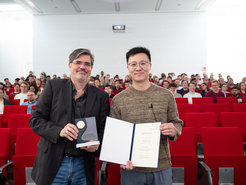Nickel catalysis: A long tradition with a bright future
Dr. Shengyang Ni Receives Thiel Award 2024
Dr. Shengyang Ni from the Max-Planck-Institut für Kohlenforschung won the Thiel Award 2024 for his innovative paper on nickel-catalyzed cross-coupling reactions.
Dr. Shengyang Ni, a postdoctoral researcher at the Max-Planck-Institut für Kohlenforschung, won the Thiel Award 2024 for his outstanding paper titled "C–heteroatom coupling with electron-rich aryls enabled by nickel catalysis and light". The jury recognized his work as the best publication by a young researcher in 2024. Published in Nature Catalysis, the paper is a transformative development in organic synthesis by simplifying and expanding the scope of nickel-catalyzed cross-coupling reactions for electron-rich compounds.

"Shengyang Nis work builds upon our institute’s rich tradition of nickel catalysis and expands it with new ideas. We are delighted to support young excellent scientists like him, who exhibit a strong passion for science with this award," says Prof. Frank Neese, managing director at the Institute. While the catalytic potential of nickel is known since the early 20th century, it was Günther Wilke, former director at the Max-Planck-Institut für Kohlenforschung (1969-1992), who laid the groundwork for modern nickel catalysis. In 1960, he discovered Ni(COD)2, a compound that is easily synthesized on a large scale and continues to play a pivotal role in industrial processes. It has served as a catalyst in over 1000 different reactions since its discovery.
The formation of carbon-heteroatom bonds is an important type of bond-forming, giving access to structures used in pharmaceuticals, agrochemical products and materials design. Transition metal catalysis based on nickel comes with several challenges: Forming carbon-heteroatom bonds with electron-rich aryl compounds is difficult due to slow oxidative addition and subsequent catalyst decomposition. Furthermore, traditional methods require special ligands to keep the reaction stable, limiting the transformation scope. Nis paper introduces a ligand-free nickel catalysis protocol powered by nickel salts under light irradiation, which solves the need for ligands and the decomposition of the catalyst. The findings pave the way for late-stage diversification in synthetic chemistry, making complex synthesis more feasible. The approach is scalable and applicable across various types of carbon-heteroatom bonds, addressing the limitations faced in traditional nickel catalysis
The Thiel Award was established in 2019 to promote young scientists at the Kohlenforschung. It honors the best publication of the previous year in memory of Prof. Dr. Walter Thiel, director emeritus, who passed away suddenly in 2019. The award is presented in the framework of the institute seminar that takes place twice every year and includes a monetary award of 2,000 euros. The institute seminar fosters networking between the different research groups at the institute. In addition to Shengyang Ni, Constanze Neumann, group leader of the “Metal Organic Framework and Nanoparticle Catalysis” group, presented her recent results on active site interactions in heterogeneous catalysis. After the presentations, the scientists came together at a poster session to network and present their recent research.
